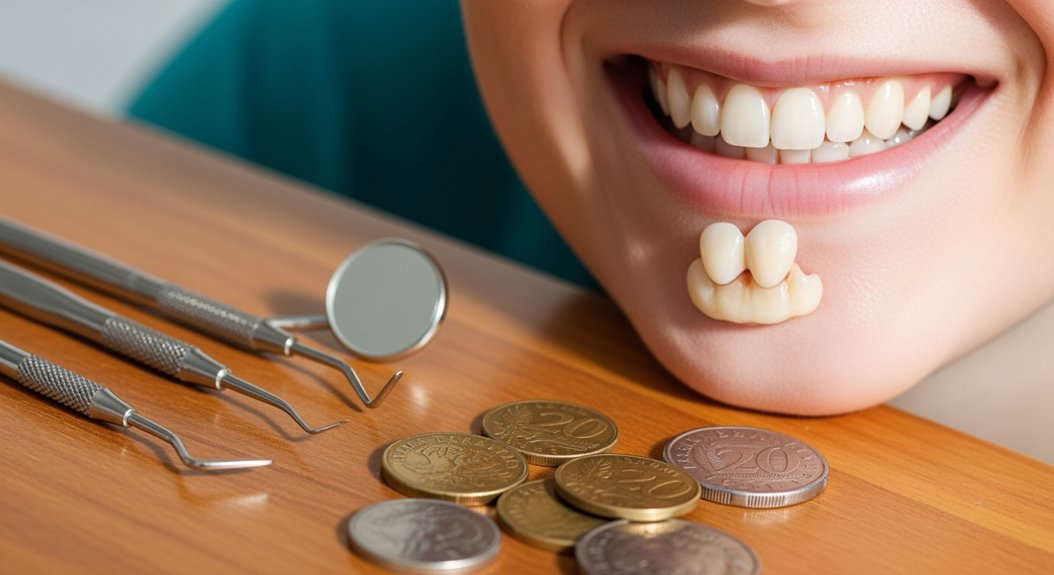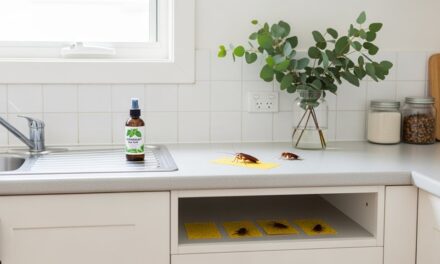Tooth crown costs in Australia typically range from AUD $1,000 to $4,700 per tooth, influenced by material choice, dental practitioner expertise, and geographic location. Metal crowns are generally less expensive, while ceramic, porcelain, and zirconia crowns command higher prices due to aesthetics and durability. Urban centers like Sydney often have higher fees than regional areas due to operational costs. Insurance coverage varies, affecting out-of-pocket expenses and payment options. Further details clarify cost factors and ways to manage treatment expenses.
Highlights
- Tooth crown costs in Australia range from AUD $1,000 to $4,700, varying by crown type and procedural complexity.
- Porcelain crowns typically cost AUD $1,200 to $2,100, while zirconia crowns start around AUD $1,800.
- Metal crowns are less expensive, ranging from AUD $1,000 to $2,000, with gold crowns starting at AUD $2,000.
- Urban dental practices charge higher prices due to increased operational costs compared to more affordable regional clinics.
- Private dental insurance may cover 50-80% of crown costs, but Medicare and public schemes offer limited support.
Average Price Range for Tooth Crowns Across Australia
While the cost of dental crowns in Australia varies widely, the national average typically ranges from $1,000 to $4,700 per tooth. This range reflects differences in crown types, procedural complexity, and the dental technology employed.
Advanced dental technology, such as digital impressions and CAD/CAM systems, can enhance precision but may increase costs. Regional factors also influence pricing, with higher rates often found in metropolitan areas like Sydney and Melbourne due to demand and operational expenses.
Additionally, the expertise of the dentist performing the procedure affects fees. Insurance coverage and payment plans can mitigate out-of-pocket expenses but vary considerably.
Common Materials Used for Dental Crowns and Their Costs
Dental crowns are commonly fabricated from materials such as metal alloys, porcelain, ceramics, including lithium disilicate, porcelain-fused-to-metal, and zirconia, each varying in cost and durability.
- Metal crowns generally offer the greatest strength at a lower price, while all-ceramic options provide superior aesthetics but at a higher expense and moderate fragility.
- The choice of material impacts not merely the crown’s longevity but also its suitability for different tooth locations and patient sensitivities.
- The dentist typically evaluates the tooth and oral health before recommending the most appropriate material to ensure the crown’s effectiveness and durability.
Popular Crown Materials
Various materials are utilized in the fabrication of tooth crowns, each offering distinct advantages regarding strength, aesthetics, biocompatibility, and cost.
- Porcelain and all-ceramic crowns provide superior aesthetics and natural appearance, with ceramic crown benefits including excellent biocompatibility and translucency, though they may be less durable. These crowns are often chosen for their ability to closely match the color of natural teeth, enhancing the overall look of the smile.
- Zirconia crowns combine strength and beauty, offering zirconia crown advantages such as high durability, precise fit due to CAD/CAM technology, and minimal allergic risk. The use of CAD-CAM technology in producing zirconia crowns eliminates casting errors and improves fit, reducing the risk of tooth decay and gum problems.
- Metal crowns excel in strength and longevity but lack aesthetic appeal, often reserved for molars. They are typically made from gold, platinum, or nickel alloys and are known to resist chipping or breaking under heavy biting forces.
- Porcelain-fused-to-metal crowns balance durability with improved aesthetics but may show metal margins over time. This combination provides a strong substructure with a natural-looking porcelain exterior.
- Composite resin and stainless steel crowns offer cost-effective, temporary solutions but are less durable and aesthetically pleasing than other options. These crowns are commonly used for short-term applications while waiting for permanent crown placement.
Cost Differences by Material
Because the choice of crown material greatly influences the overall expense, understanding the cost differences among common dental crown materials is essential for informed decision-making. Materials vary in crown longevity and material aesthetics, impacting suitability and price. Porcelain and ceramic crowns offer superior aesthetics but moderate longevity, costing $1,200–$1,800. Zirconia crowns provide enhanced durability and natural appearance, priced from $1,800.
Porcelain fused to metal balances strength and aesthetics at lower costs, starting around $1,200. Metal and gold crowns excel in longevity but lack aesthetic appeal, with metal from $1,000 and gold from $2,000. Additionally, the strength and durability of each material should be considered to match the crown’s functional needs.
| Material | Average Cost (AUD) |
|---|---|
| Porcelain | $1,200 – $2,100 |
| Ceramic | $1,500 – $1,800 |
| Zirconia | From $1,800 |
| Porcelain Fused to Metal | From $1,200 |
| Metal and Gold | $1,000 – $2,000 |
Material Durability and Price
Material selection greatly impacts both the durability and cost of dental crowns.
- Crown material comparisons reveal significant differences in longevity and price, influencing their suitability as a long-term investment.
- Zirconia crowns offer exceptional strength and durability, lasting 15 to 20 years, but at a higher cost.
- Metal crowns, typically gold or palladium, provide excellent wear resistance and affordability, often lasting a lifetime.
- Porcelain and ceramic crowns prioritize aesthetics with lifespans of 10 to 15 years, though they are more prone to chipping.
- Porcelain-fused-to-metal (PFM) crowns balance durability and appearance, lasting 10 to 15 years at a moderate price.
- Additionally, the placement of the crown affects material choice, as molars require stronger crowns, like metal or zirconia, to withstand more wear.
Understanding these material characteristics enables patients to make informed decisions, aligning durability needs with budget considerations.
How Location Influences Crown Pricing in Australian Cities
While dental crown costs across Australia show some consistency, location plays a significant role in price variation, especially between major cities and regional areas.
The location impact is evident as metropolitan clinics in Sydney, Melbourne, and Brisbane typically charge between AUD $1,100 and $2,000 per crown, with Melbourne often presenting higher starting prices for porcelain and specialty materials.
Metropolitan clinics in Sydney, Melbourne, and Brisbane charge AUD $1,100-$2,000 per crown, with Melbourne often higher.
- Pricing trends reflect urban operational costs such as rent, salaries, and demand, driving prices upward compared to rural settings, where costs are generally lower.
- Additionally, city clinics leverage advanced technology and specialist services, contributing to higher fees.
- The average cost of a dental crown in major cities like Sydney, Brisbane, and Melbourne falls within this range due to the consistent quality of dental services.
- The dense competition in urban markets offers patients diverse options and transparent pricing, sometimes accompanied by payment plans.
Consequently, location strongly influences crown pricing through economic factors and service availability across Australian cities.
Additional Treatments That Affect the Total Crown Cost
Additional treatments such as root canal therapy and gum disease management can considerably increase the total cost of a tooth crown. It is important to note that the custom-designed crowns provided at Melbourne clinics are tailored to protect and restore natural tooth function, which can influence the overall cost. Implant placement and associated dental lab fees also contribute to the overall expense, depending on the complexity and materials used.
These factors must be considered when estimating the final financial commitment for crown procedures.
Root Canal Expenses
Because root canal treatment often precedes the placement of a dental crown, its costs greatly influence the total expense of restoring a damaged tooth. Treatment options vary by tooth type, complexity, and infection severity, impacting prices markedly. Front teeth root canals are simpler and less costly, while molars require more extensive treatment. The procedure involves removing the infected pulp, cleaning, disinfecting, and sealing the root canals to prevent further infection, which is essential to save the natural tooth and avoid extraction (dental procedure).
| Tooth Type | Average Root Canal Cost (AUD) |
|---|---|
| Front Teeth | $900 – $1,500 |
| Premolars | $1,200 – $1,800 |
| Molars | $1,500 – $2,500 |
| Complex Cases | $2,000 – $3,400 |
Additional infection control procedures and dental expertise also affect costs. Dental insurance may offset expenses, but crowns represent a further financial consideration after root canal therapy.
Gum Disease Management
Effective management of gum disease is a crucial factor influencing the overall cost of dental crown procedures.
- Treatment options range from non-surgical interventions such as debridement, scaling, and root planing, and professional cleanings, to surgical procedures including flap surgery, bone and soft tissue grafting, and pocket reduction surgery.
- Diagnostic measures like dental X-rays, periodontal probing, and specialist examinations further contribute to expenses.
- These treatments are essential to stabilize gum health, reduce inflammation, and guarantee proper crown fit and longevity.
- It is important to note that keeping teeth clean can be challenging in advanced stages of gum disease, making professional treatment necessary.
- Additionally, the use of local or general anesthesia during procedures adds to the total cost.
- Maintenance through frequent check-ups and cleanings before and after crown placement also affects overall expenditure.
Hence, thorough gum disease management greatly impacts the final price of dental crowns in Australia.
Implant and Lab Fees
Implant and laboratory fees represent significant components in the overall cost structure of dental crown treatments in Australia. Implant fees vary widely, typically ranging from AUD 1,999 to 6,500 per implant, influenced by surgical complexity and additional procedures like bone grafting.
The average cost of dental implants usually ranges from $1,999 to $3,999 per implant and includes the implant, abutment, and crown. Lab fees depend on crown materials and fabrication methods, affecting both cost and crown longevity. High-quality labs and advanced digital milling increase fees but enhance patient experiences through better fit and durability.
| Fee Type | Cost Range (AUD) | Impact on Treatment |
|---|---|---|
| Single Implant | 1,999 – 6,500 | Surgical cost, crown included |
| Complex Implants | Up to 7,000+ | Additional procedures required |
| Lab Fees | 200 – 600+ | Material and fabrication dependent |
| Bone Grafting | 500 – 2,000+ | Supports implant stability |
| Temporary Crowns | 150 – 300 | Interim protection during treatment |
Comparing Costs of Different Crown Types
How do the costs of dental crowns vary across different materials in Australia?
Porcelain or ceramic crowns, starting around $1,500, are favored for their aesthetic appeal, especially on front teeth, balancing crown longevity with natural appearance.
Porcelain or ceramic crowns start at $1,500, ideal for front teeth with a natural, lasting look.
- Zirconia crowns, priced from $1,600 to $1,800, offer superior durability and wear resistance, suitable for back teeth where strength is critical.
- Porcelain-fused-to-metal (PFM) crowns begin at approximately $1,200, combining aesthetics and strength, though metal edges may affect long-term cosmetic preferences.
- Metal crowns, including gold, start near $2,000, valued primarily for longevity rather than aesthetics.
- Resin crowns are the most affordable at about $300 but are typically temporary due to limited durability.
Consequently, material choice greatly influences cost, reflecting trade-offs among crown longevity and aesthetic preferences. Additionally, tooth location plays a significant role in selecting the appropriate crown material, affecting both appearance and strength requirements.
Impact of Tooth Position on Crown Expenses
Dental crown costs frequently vary depending on the tooth’s position within the mouth, reflecting differences in aesthetic requirements, functional demands, and material choices.
- Crowns on front teeth, such as incisors and canines, demand higher aesthetic considerations, necessitating materials like porcelain or zirconia for natural translucency and precise color matching. This increases both laboratory complexity and cost. Porcelain Crowns are ideal for front teeth due to their high aesthetic appeal and natural appearance.
- Conversely, crowns for back teeth, including premolars and molars, prioritize strength and wear resistance, often using durable materials such as metal or porcelain-fused-to-metal, which may lower expenses.
- Functional requirements, like withstanding higher bite forces on molars, also influence material selection and crown longevity.
Additionally, insurance coverage often favors back tooth crowns due to their functional necessity, while front tooth crowns are frequently out-of-pocket expenses owing to their cosmetic classification.
Role of Dentist Experience in Crown Pricing
While tooth crown costs are influenced by multiple factors, the experience level of the dentist plays a significant role in determining pricing.
Dentist expertise affects pricing strategies as more experienced clinicians typically charge higher fees reflecting refined techniques, advanced skill sets, and longer chair time required for complex cases. Such practitioners often select premium materials and collaborate with quality laboratories, increasing crown costs. Moreover, the type of dental crown chosen can vary with the dentist’s recommendation, impacting overall price.
Additionally, seasoned dentists efficiently manage overheads and deliver superior outcomes, reducing complications and rework. Their ability to customize crowns suited to patient needs justifies premium pricing.
Practice reputation and geographic location, linked to dentist experience, further influence fees. Ultimately, patients often perceive higher costs as an investment in durability and aesthetics, valuing expert care over initial expense.
Insurance Coverage and Payment Options for Crowns
Where can patients find financial support for tooth crowns in Australia?
Primarily, private dental extras insurance with Major Dental coverage offers partial reimbursement, typically covering 50% to 80% of costs after a 12-month waiting period. Coverage depends on the policy tier and whether the crown is medically necessary. A crown is a fitted cap placed over an entire tooth to protect it from further damage or decay, making the procedure often essential for long-term dental health. Tooth crown overview.
Medicare offers limited assistance, mainly for emergencies or eligible children under the Child Dental Benefits Schedule. Public dental schemes provide minimal support, usually only in urgent cases.
Patient experiences reveal substantial out-of-pocket expenses, often 50% to 85%, influenced by crown materials and policy details.
To ease financial burden, many dental clinics provide flexible payment plans, including interest-free options. Understanding insurance terms and exploring alternative financing is essential for managing costs while ensuring crown longevity and satisfactory patient outcomes.
Cost Differences Between Urban and Regional Dental Practices
Although the quality of tooth crown treatments remains consistent across locations, significant cost variations exist between urban and regional dental practices in Australia.
- Urban dental practices typically incur higher operating costs, which contribute to increased crown prices. These practices often provide a wider selection of crown materials and specialized treatments, benefiting from urban accessibility but sometimes imposing additional expenses such as parking fees. The choice of material used in crowns can significantly influence the final cost, with some materials being more expensive than others.
- Conversely, regional services generally offer more affordable options due to lower overheads and strong community ties, though material choices may be more limited. Patients in regional areas might also face travel requirements when seeking specialized care unavailable locally.
Economic factors within each region further influence pricing, with urban centers reflecting higher demand and costs compared to more economically constrained regional settings.
Tips for Managing and Reducing Crown Treatment Costs
Effectively managing crown treatment costs involves leveraging insurance benefits and exploring available payment plans to reduce the immediate financial burden. Many health insurance policies offer partial coverage for crowns, which can significantly offset the overall expense. Selecting affordable yet durable materials can also contribute to cost savings without compromising quality. Additionally, scheduling treatments efficiently to minimize additional procedures helps control overall expenses.
Insurance and Payment Plans
Several strategies exist to manage and reduce the costs associated with tooth crown treatments in Australia, primarily through insurance coverage and flexible payment options.
Private dental insurance typically covers 50-80% of medically necessary crown costs under major dental extras policies, though waiting periods and exclusions for cosmetic crowns apply. It is important to note that dental crowns are classified as major work, which affects insurance coverage and claim processing. Government programs offer limited support, mainly for children or concession card holders, while most adults rely on private insurance or self-funding.
Understanding insurance limits and waiting periods helps avoid unexpected expenses. Additionally, many dental clinics provide payment options such as interest-free installment plans or third-party financing, allowing patients to spread costs over time.
Discussing payment options upfront with providers guarantees transparency and aids financial planning. These measures collectively promote more affordable access to crown treatments.
Choosing Affordable Materials
Managing the costs of tooth crown treatments extends beyond payment methods to the selection of materials used for the crowns themselves.
- Material selection considerably influences overall expenses, with options ranging from affordable metal crowns starting around $1,000 to more costly porcelain crowns costing up to $2,500.
- Resin crowns offer a cheaper alternative but serve primarily as temporary solutions due to limited durability. Porcelain crowns are custom-made for a perfect fit to improve function and appearance.
- Conducting a cost comparison across materials, such as zirconia, porcelain fused to metal, and resin, allows patients to balance aesthetics, durability, and budget.
- Additionally, choosing prefabricated crowns over custom-made options can reduce costs, though fit quality may be compromised.
Strategic material selection, informed by a thorough cost comparison, is essential for managing and reducing crown treatment expenses effectively.
Scheduling Efficient Treatments
When dental practices prioritize the scheduling of crown treatments, aligning appointment times with staff productivity and patient availability can markedly influence overall costs.
- Effective scheduling strategies include allocating complex crown procedures to morning sessions when clinical staff are most alert, and reserving buffer times to manage unforeseen delays without disrupting the workflow.
- Routine check-ups are often scheduled midday, optimizing patient experience by accommodating their availability. Utilizing Dental Block Scheduling to allocate specific time blocks for different procedures creates a clear roadmap for daily operations.
- Employing 10-minute increments and categorizing procedures enhances time management, ensuring appointments proceed efficiently while maintaining quality care.
- Additionally, incorporating emergency slots prevents schedule disruptions.
Optimizing these elements reduces overhead and indirect treatment costs.
Frequently Asked Questions
How Long Does a Dental Crown Typically Last in Australia?
Dental crown longevity in Australia typically ranges from 10 to 15 years, influenced by material and oral hygiene. Maintenance tips include regular dental check-ups, proper brushing, flossing, and avoiding damaging habits to extend the crown’s lifespan effectively.
Are There Any Risks or Complications Associated With Getting a Crown?
Crown complications may include pain, sensitivity, crown failure, infection, and allergic reactions. Dental risks involve poor fit, gum inflammation, structural damage, and aesthetic concerns. Timely dental care mitigates potential adverse outcomes effectively.
What Is the Usual Time Frame for Crown Placement From Start to Finish?
The usual time frame for crown placement spans approximately 2 to 4 weeks. This includes initial consultation, tooth preparation, laboratory fabrication, appointment scheduling, and final crown placement with necessary adjustments for ideal fit and function.
Can a Dental Crown Be Whitened if It Becomes Discolored?
Dental crowns cannot be whitened due to their fixed coloration and material composition. Effective crown maintenance, including hygiene and dietary care, helps prevent discoloration caused by factors such as staining, aging, and material degradation.
How Do Dentists Determine if a Crown or Implant Is Better?
Dentists evaluate crown advantages such as cost-effectiveness, preservation of natural teeth, and quicker procedures against implant benefits, including durability, bone preservation, and suitability for missing teeth, considering patient health, aesthetics, and long-term oral function.










